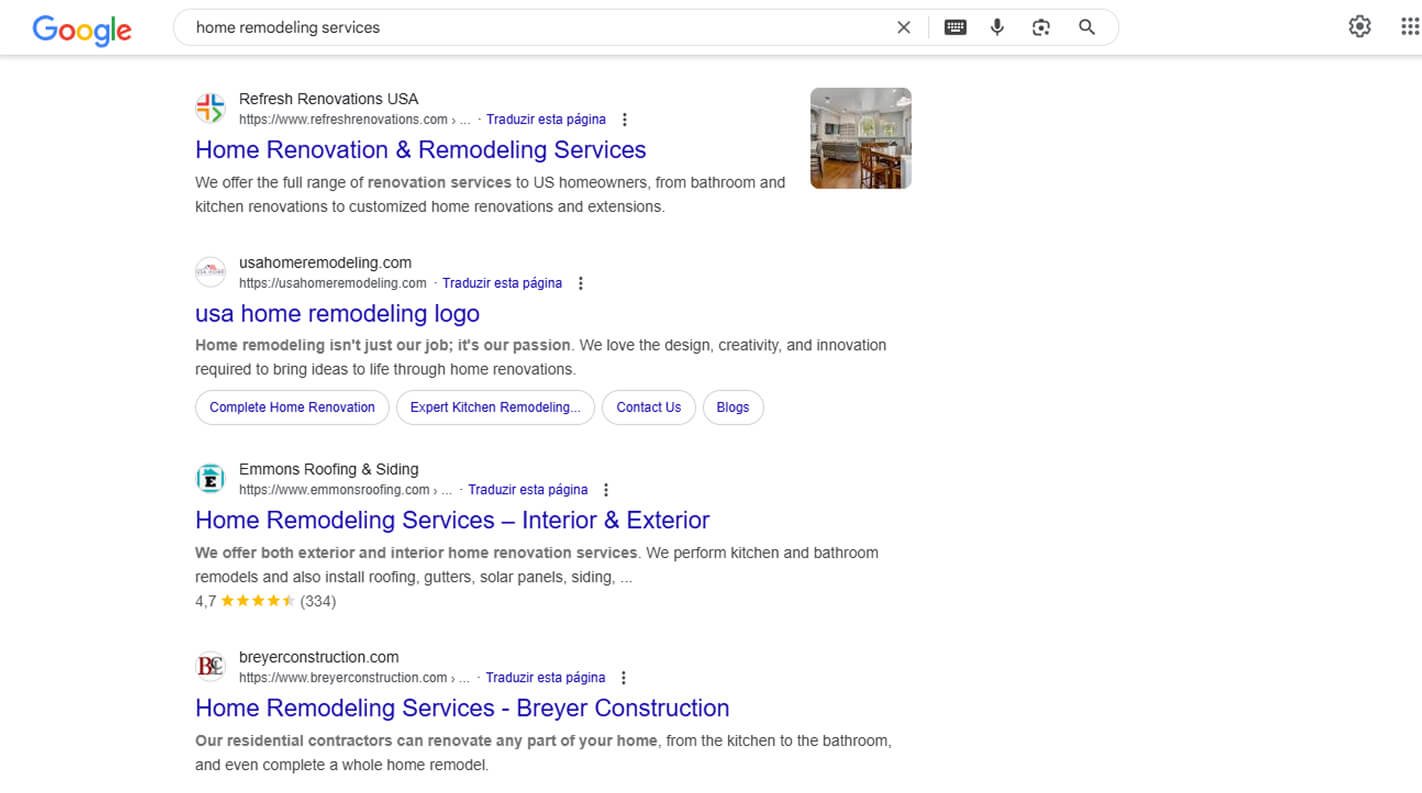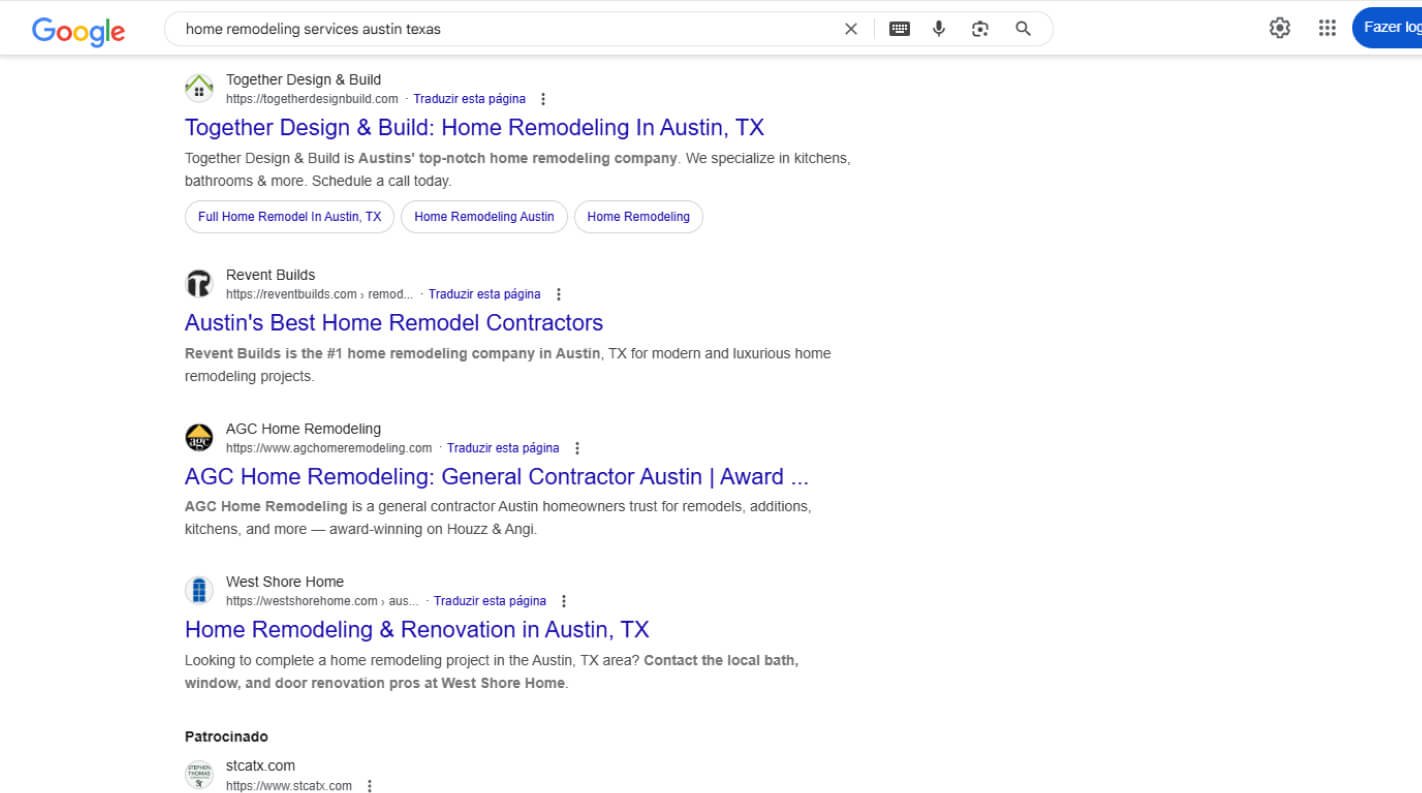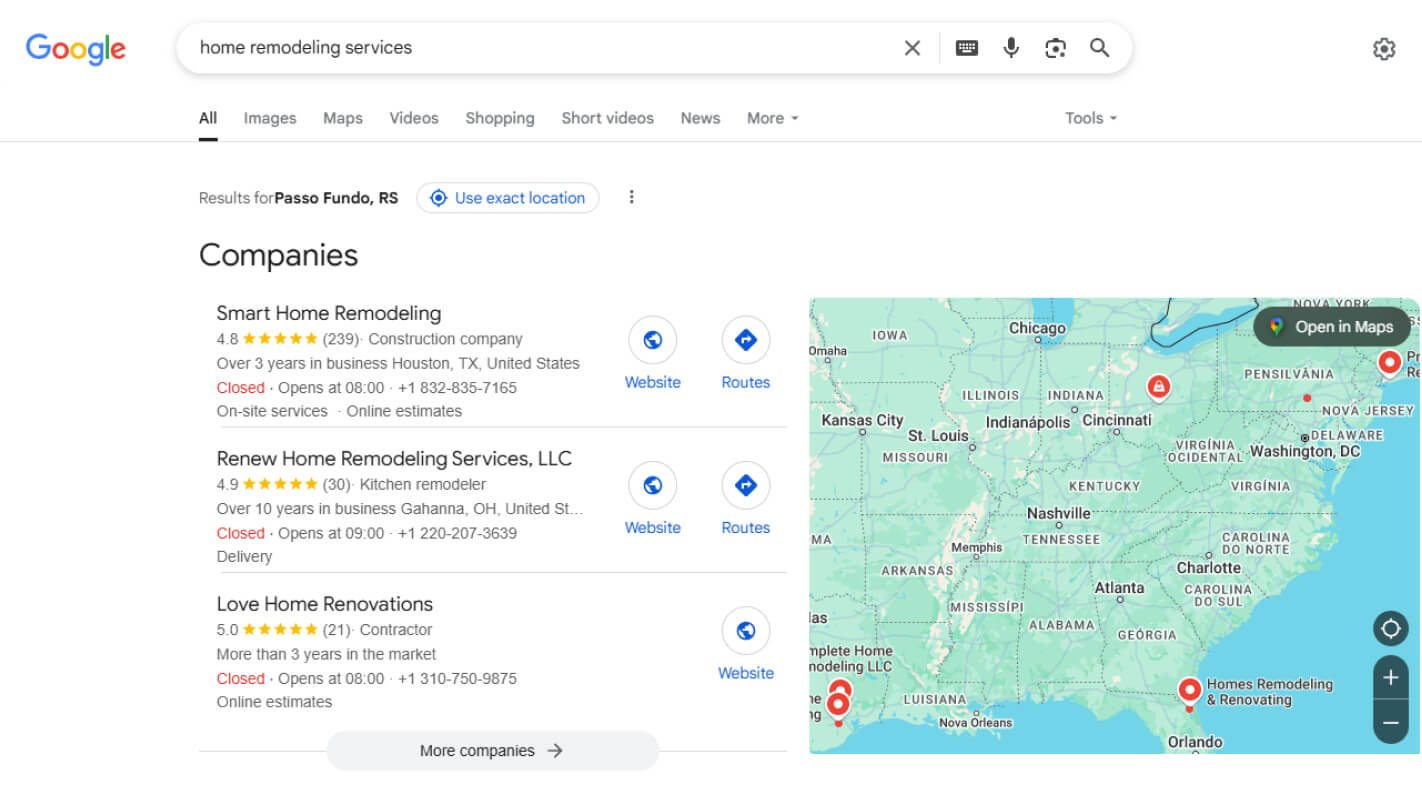Introduction

If you own a home remodeling or renovation business, you know how competitive the market is. Homeowners are searching online for services like “kitchen remodelers near me” or “bathroom renovation experts”, but how do you make sure they find your business?
The answer is SEO (Search Engine Optimization). SEO helps your website rank higher in Google, driving local, high-quality leads that turn into paying customers. In this guide, we’ll break down simple, actionable SEO strategies tailored for home services businesses. Let’s dive in!
1. Understand Your Audience and Conduct Keyword Research

Let’s get inside your customer’s head. Homeowners don’t just search for “kitchen remodeling”, they type specific phrases like “affordable kitchen remodelers near me” or “emergency bathroom renovation in [City].” These keywords reveal their location, budget, and urgency. Your job? Find and use these phrases to attract ready-to-buy clients.
How to start:
- Use free tools like Google Keyword Planner or AnswerThePublic to discover what your audience is asking.
- Paid tools like SEMrush or Ahrefs dig deeper, showing keyword difficulty and competitor gaps.
- Focus on long-tail keywords (3–5 words). Example: “small bathroom remodel cost 2024” beats vague terms like “bathroom remodel” because it targets homeowners ready to hire.
Pro tips for home services:
- Add neighborhoods or landmarks: “kitchen remodelers near [Local School].”
- Solve problems: Use keywords like “fix leaky roof fast” or “replace outdated electrical wiring.”
- Research your competitors: Find out which keywords are driving their traffic. Steal their best ideas (ethically!).
Example: Why “long-tail” works
| Keyword | Monthly Searches | Intent |
| “home remodeling” | 1,000 | Too broad, not urgent |
| “kitchen remodel cost 2024” | 200 | High intent to hire |
Remember: Homeowners aren’t searching for “remodeling services”, they’re asking for solutions. Match their words, and you’ll match their needs!
2. Optimize Your Website for On-Page SEO
Think of your website like a digital storefront. If it’s cluttered, slow, or confusing, customers will leave (and Google will notice). On-page SEO is about making your site easy to love for both visitors and search engines.
Quick fixes to boost rankings:
- Title tags & meta descriptions: Pack them with keywords and benefits.
- Example: “Trusted Kitchen Remodelers in [City] | 10+ Years of Expertise”
- Headers (H1/H2): Use clear, keyword-rich headings to guide readers.
- Bad: “Services We Offer”
- Good: “Affordable Bathroom Remodeling Services in [City]”
- Internal links: Use internal linking by connecting your “bathroom remodeling” and “plumbing services” pages. It improves navigation and helps search engines map your site structure.
Speed matters!
53% of users bounce if your site takes over 3 seconds to load. Use Google PageSpeed Insights to test speed. Fix issues like oversized images or clunky code.
Mobile-friendly = Non-negotiable:
Over 60% of searches happen on phones. Test your site with Google’s Mobile-Friendly Tool. If buttons are too small or text is unreadable, you’re losing leads.
Pro tip: Add a “service area” page with ZIP codes you serve. Google loves local clarity!
Why this works: On-page SEO turns your website into a lead magnet by speaking your customers’ language and satisfying Google’s algorithms.
3. Create Location-Specific Pages

Homeowners don’t just search for “kitchen remodelers”, they type “kitchen remodelers in [City]” or “bathroom renovation experts near [Landmark].” If your website doesn’t mention their location, Google won’t show it to them. That’s where location-specific pages save the day!
How to build these pages:
- List every area you serve: Create separate pages for each city, neighborhood, or ZIP code (e.g., “Kitchen Remodeling in Austin” and “Bathroom Renovation in Round Rock”).
- Use local keywords naturally:
- Mention nearby landmarks, schools, or parks: *“We’ve transformed 50+ homes near Zilker Park!”*
- Include phrases like “serving [City] since 2010” to show authority.
- Add customer stories: Feature testimonials from clients in specific areas. Example: “Sarah from East Austin loved her kitchen makeover!”
Why this works:
- Google ranks pages higher when they match the searcher’s location.
- Homeowners trust businesses that “get” their community.
Pro tips:
- Avoid generic content. Keep your tone conversational, like you’re chatting with someone next door.
- Use free tools like Google Trends to find local search spikes (e.g., “pool remodeling” surges in summer).
- Link location pages to your service pages (e.g., link “Austin kitchen remodel” to your main “kitchen services” page).
Example of keyword targeting:
| Generic Keyword | Location-Optimized Keyword |
| “home remodeler” | “home remodeler in San Antonio” |
| “bathroom renovation” | “bathroom renovation near Lake Travis” |
Bottom line: Location pages turn your website into a local magnet, pulling in homeowners who are ready to hire, not just browse.
4. Claim and Optimize Your listing on Google Business Profile (GBP)

Your Google Business Profile is like a free billboard on Google’s front page. When homeowners search for “kitchen remodelers near me,” your GBP listing pops up with photos, reviews, and a click-to-call button. Ignore this, and you’re missing out on easy leads!
How to nail your GBP:
- Fill every detail: Name, address, phone, hours, and service areas (e.g., “Serving Dallas, Fort Worth, and Arlington”).
- Add photos that sell: Before/after project shots, team photos, or videos of your work. Update these monthly to keep your profile fresh.
- Post weekly updates: Share promotions (“$500 Off Bathroom Remodels This Month!”), project highlights, or FAQs.
Reviews = Trust:
- Ask happy clients to leave reviews. Just 5+ reviews can boost your local rankings.
- Respond to every review (even negative ones). A simple “Thanks!” or “We’ll fix this!” shows you care.
Why this works: Google loves active, complete profiles. An optimized Google profile boosts credibility and increases your chances of appearing in the top 3 local results.
5. Produce High-Quality, Relevant Content
Imagine a homeowner Googling “how much does a bathroom remodel cost?” If your blog answers that question clearly, guess who they’ll call next? You.
Content isn’t just filler, it’s your chance to show expertise, answer worries, and turn readers into clients.
Content ideas that work for home services:
- Blogs: Write about trends, costs, or how-tos.
- Examples:
- “2024 Kitchen Design Trends Homeowners Love”
- “How to Avoid Common Mistakes in Bathroom Remodels”
- Examples:
- FAQs: Address fears like budget or timelines.
- Example: “Is My Home Too Old for a Renovation? (Spoiler: No!)”
- Videos: Film a “day in the life” of a project or explain permits.
Why this works:
- Content with keywords like “home remodeling costs” or “kitchen renovation tips” ranks higher in Google.
- Homeowners bookmark helpful guides and share them with friends.
Pro tips:
- Incorporate keywords into your H2 and H3 headings to organize your content and improve SEO.
- Add before/after sliders or project galleries to keep readers engaged.
- Repurpose content: Turn a blog into a YouTube video or Instagram carousel.
SEO checklist for content:
✅ Include keywords in the first 100 words.
✅ Link to related service pages (e.g., link “bathroom remodel tips” to your bathroom services page).
✅ Add descriptive alt text to your images, such as “contemporary kitchen renovation in Miami,” to help with search visibility.
Don’t overcomplicate it! Write like you’re advising a friend. Answer their burning questions, and Google will reward you with traffic.
Need inspiration? Start with one blog or video this week. Consistency beats perfection!
6. Build Local Citations and Earn Quality Backlinks
Think of local citations and backlinks as digital gold stars for your business. Citations (mentions of your business name, address, and phone number online) tell Google you’re legitimate. Backlinks (links from other sites to yours) act like votes of confidence, boosting your authority. Combined, these strategies improve your rankings and bring in more customers from your area.
How to build citations:
- Claim free listings on:
- Google Business Profile (non-negotiable!)Yelp, Angi, HomeAdvisor, and Houzz (homeowners love these).
- Local directories like your Chamber of Commerce or neighborhood Facebook groups.
- Keep your NAP consistent: Ensure your Name, Address, Phone match exactly everywhere. Even small tykes (like “St.” vs. “Street”) confuse Google.
How to earn backlinks:
- Partner with local businesses: Team up with interior designers or realtors to write guest blogs (e.g., “How to Prep Your Home for a Renovation”).
- Create shareable content: Publish a “Homeowner’s Guide to Permits in [City]” and share it with local contractors or city websites.
- Sponsor community events: Local charities or schools often link to sponsors on their sites.
Free and paid example directories
| Free | Paid |
| Google Business Profile | Angi Leads |
| Yelp | HomeAdvisor Pro |
| Bing Places | Houzz Premium |
Pro tips:
- Use BrightLocal to track citations and fix inconsistencies.
- Avoid “link farms” or spammy sites, Google penalizes these!
Why this works: Citations and backlinks make Google trust your business and put you ahead of competitors. Start with 1–2 directories this week, and watch your local visibility grow!
7. Track Leads and Optimize Continuously
SEO requires ongoing effort, it’s not a one-time task you can walk away from.. To turn traffic into paying clients, you need to track where leads come from and tweak your strategy. It’s like maintaining a vehicle, regular tweaks keep performance steady over time.
How to track leads effectively:
- Use free tools:
- Google Analytics: See which pages bring the most traffic (e.g., your “bathroom remodel” page might be a star).
- Google Search Console: Find keywords you’re ranking for (but not yet hitting page 1).
- Call tracking: Apps like CallRail show which SEO campaigns drive phone calls.
- Example: A roofing company discovered 60% of calls came from their “emergency roof repair” blog, so they doubled down on similar content.
Key metrics to watch:
| Metric | Why It Matters |
| Organic traffic | Measures SEO growth |
| Conversion rate | Shows how many visitors become leads |
| Bounce rate | Flags pages that need improvement |
Optimize based on data:
- If your “kitchen remodeling” page has a high bounce rate, add more photos or simplify the contact form.
- If “home addition costs” is a top keyword, write a follow-up guide like “Budgeting for Home Additions in 2024.”
Automate lead capture:
- Tools like Leadformly or chatbots (e.g., ManyChat) grab visitor info 24/7, even when you’re asleep.
Pro tips:
- Review SEO performance monthly.
- A/B test headlines or CTAs (e.g., “Get a Free Quote” vs. “Schedule Your Consultation”).
Why this works: Tracking turns guesswork into actionable wins. Every tweak gets you closer to a website that works as hard as you do.
FAQs: Top Pain Points for Local SEO
1. “When will I start seeing results from SEO?”
SEO is a long-term strategy. While you might see small wins (like better rankings for low-competition keywords) in 3-6 months, significant traffic and lead growth usually take 6-12 months. Why? Google needs time to trust your site. Consistency is key, keep publishing content and optimizing!
2. “SEO vs. Google Ads: Which is better for home services?”
SEO builds lasting visibility (like owning a house). It’s cost-effective long-term but slower.
Google Ads delivers fast traffic, similar to renting space on a busy highway.. Great for quick leads but stops working when you pause spending.
Ideal combo: Use SEO for steady growth and Google Ads to fill gaps (e.g., promoting seasonal offers).
3. “What if I get a negative review online?”
Respond politely and offer to fix the issue publicly (e.g., “We’re sorry your experience wasn’t perfect. Let’s make this right!”). Most homeowners appreciate transparency. A few negative reviews mixed with positives actually look more authentic than all 5-star ratings.
4. “I’m not tech-savvy. Can I DIY SEO?”
Start small! Focus on basics:
Claim your Google Business Profile.
Write 1-2 blogs/month answering common questions.
Fix website speed with tools like Google PageSpeed Insights.
For advanced tactics (like backlinks or technical SEO), consider hiring a pro.
5. “How do I compete with bigger companies in search results?”
Win locally:
Big brands can’t beat hyper-local SEO. Dominate keywords like “kitchen remodeler in [Your City]” with location pages, local content, and reviews. Google prioritizes businesses that are relevant to the searcher’s area.
Conclusion
SEO isn’t magic, it’s a grind. But for home services businesses, it’s the grind that pays off. By targeting local keywords, optimizing your website, and building trust through Google Business Profile and content, you’ll attract homeowners who are ready to hire, not just browse.
The best part? SEO keeps working for you long after the work is done. Unlike paid ads that vanish when the budget dries up, a well-optimized site becomes a 24/7 lead machine. But let’s be real: running a business is already a full-time job. Between juggling projects, crews, and clients, who has time to obsess over meta tags or backlink audits?
That’s where Venaly Digitals comes in. We’re a team of Home Services SEO nerds who’ve helped businesses like yours:
- Dominate local keywords like “emergency plumber in [Your City]” or “kitchen remodeler near [Landmark].”
- Transform your Google profile into a review hub by collecting dozens of five-star testimonials.
- Build websites that load fast, convert visitors into leads, and stay on page 1.
We don’t do vague promises or flashy jargon. Just honest, hands-on SEO, like a trusted partner who handles the tech stuff so you can focus on your craft.
Ready to stop missing out on local leads?
Book a free SEO audit with us. We’ll show you exactly where your site stands and how to fix gaps (no sales pitch, ever). Let’s turn your website into the hardest-working tool in your toolbox.
P.S. You don’t need to be an SEO expert, you just need the right team. Let’s chat! 💬